If your competitors are crushing you online, it could have something to do with your content. And if you want to get an accurate look at how your articles or blog posts are performing in relation to other brands in your space, you’ve got to do some digging.
You’ll need a good tool in your arsenal for understanding your competitors’ content strategies. One that’s worth checking out is Content Explorer, a feature from Ahrefs that allows you to take a peek inside other websites’ content strategies:
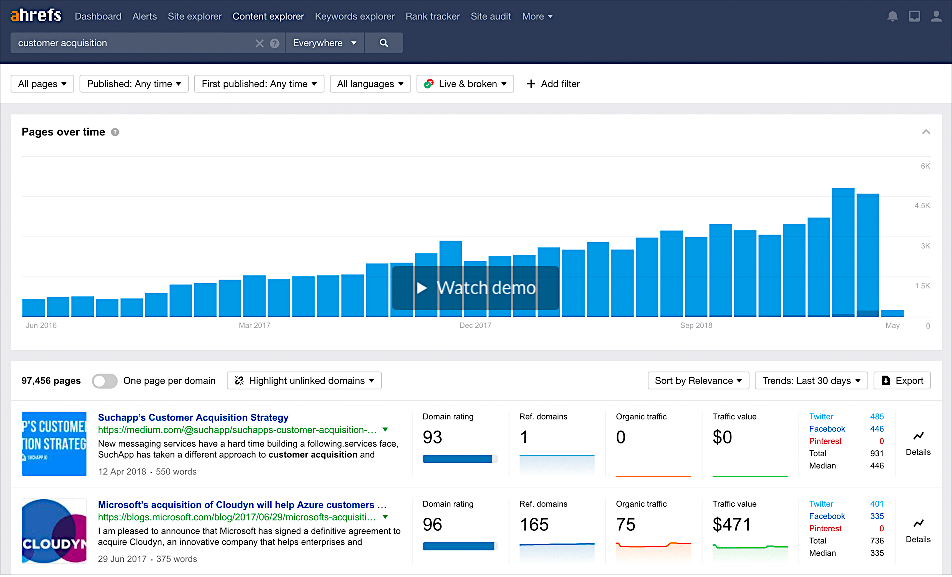
Content Explorer Features
I’ve long been a fan of Ahrefs for SEO, specifically the Keywords Explorer tool, which allows marketers to search nearly seven billion keywords in over 170 countries and assess metrics like keyword difficulty, click-through rates, related keywords and search volume. In short, it’s the most comprehensive keyword tool available right now.
The relaunch of Content Explorer gives me another good reason to stick with Ahrefs, as it can tell you everything about your competition’s content, including:
- Social shares
- Traffic
- How often they’re updating that content
- When it was originally published
Basically, the tool tells you every little thing that your competition is doing with their content. More importantly, it tells you which things your rivals are succeeding at, and helps you highlight the areas in which you may be able to gain an advantage.
It’s important to note that Content Explorer doesn’t just bill itself as a way to discover your competition’s strategy. It has a ton of other features that are highlighted as essential for any content marketer, including the ability to:
- Discover popular content around specific keywords, based on social shares, organic search traffic and referring domains
- Highlight unlinked mentions of your website or brand, which could be used for backlink building campaigns
- Filter results according to language, domain rating, word count and backlinks. The language filter is particularly helpful because you can see if brands are publishing content in other languages, which could help you find new markets you might not have previously considered.
And specific features of Content Explorer 2.0 include:
- Broken (404 & 410) pages
- Published & republished dates
- Content trends graph
- New in-line charts
- UI and filtering improvements
Overall, Content Explorer a comprehensive tool for finding popular content for any topic. The deeper you dig, the more you can learn about your content, your competitors and where the searches for your keywords and industry are going.
Dive Deeper:
- How to Perform Marketing Competitor Analysis (+ 6 Best Tools Comparison)
- 10 Tools to Monitor Your Competitors’ Growth and Hack Their Strategies
- How to Conduct Smart Competitor Research for Better Customer Acquisition
Our Content Explorer Test: Backlinko
I don’t think we’re spilling any secrets here since Brian Dean of Backlinko is pretty open about his content and SEO strategies. (It’s kind of his whole deal.)
We entered backlinko.com into the Content Explorer to give it a test run. We could immediately see his whole content strategy, including:
- How often he’s publishing
- How often he republishes (meaning how often he updates his content)
- How long his content pieces typically are (3,500-4,000 words)
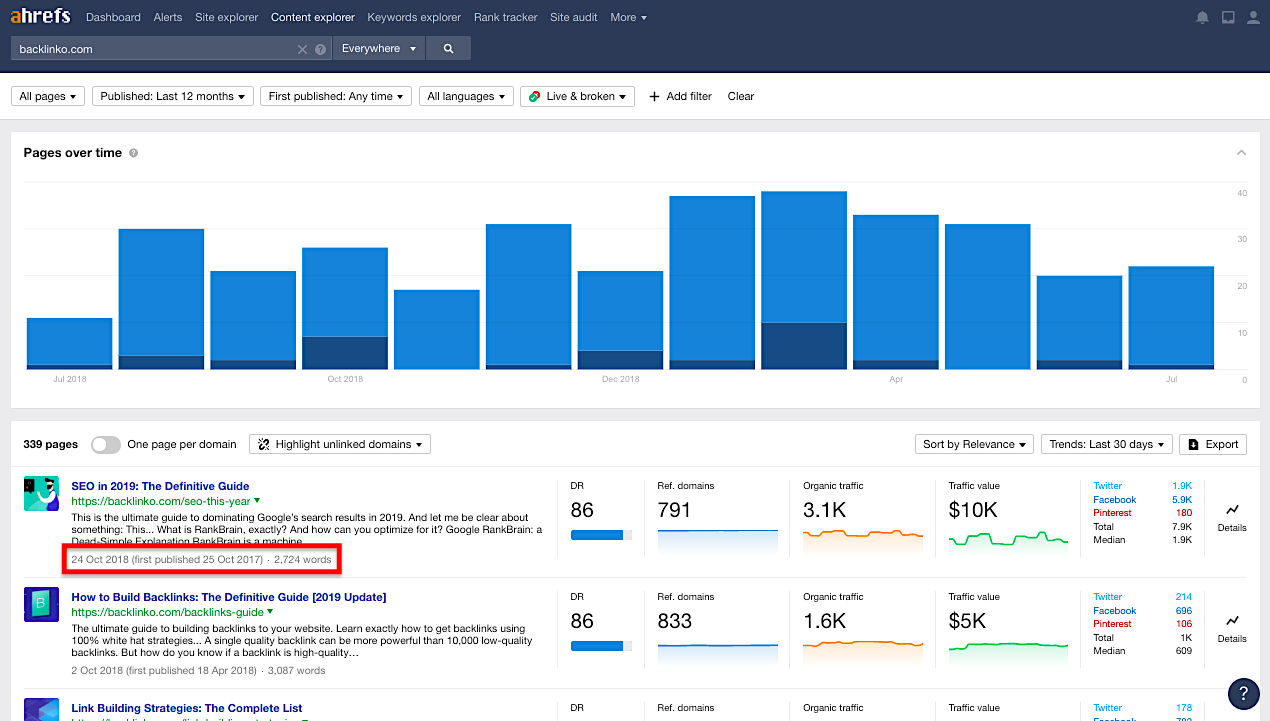
You can see that more than half of his content has been updated in the last 90 days. His competitors aren’t doing that. They’re spending a lot of time producing new content, but not nearly enough upgrading what they already have.
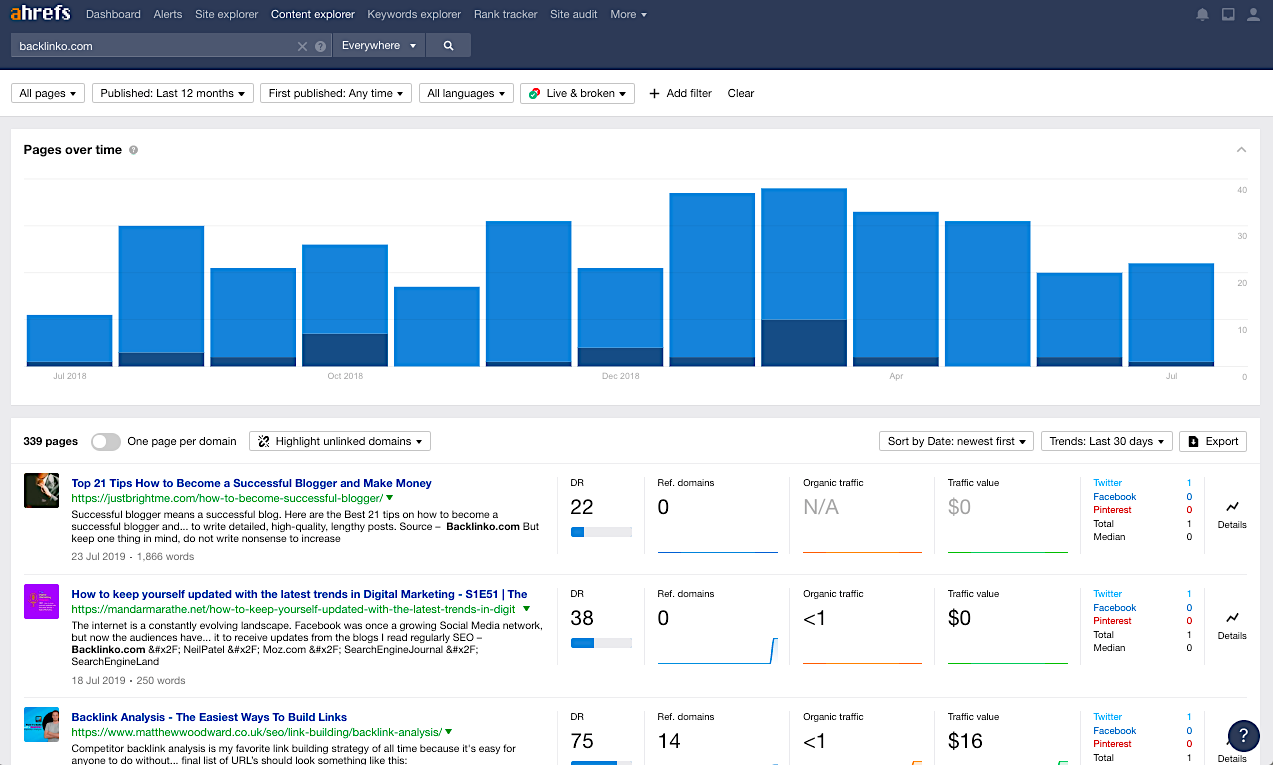
If you’re Brian Dean’s competition, this is useful information to have. It may mean shifting your own content strategy to focus on more comprehensive, evergreen pieces instead of churning out frequent short pieces on the Next Big Thing in SEO – essentially, focusing on quality over quantity.
As a reference point, I also looked up the Single Grain website in Ahrefs and compared it to the data we have on our end. It’s both thorough and accurate.
The Pros and Cons of Ahrefs
Google updates their algorithms all the time, and then everyone has to scramble to catch up, SEO-wise. You may notice a big dip in traffic after an update.
One of the great things about Content Explorer is that you can see if your competition is suffering a similar fate. If they are, then you have an opportunity to figure out how to improve your ranking before they do. If they aren’t, then you can figure out what they’re doing, and do it better.
I think using a tool like Ahrefs is much more powerful than just reading a blog post from me or Neil or any other marketer who shares tips for content strategy and improving SEO. You’ll get some great tips from reading, sure, but not all the tips you read about will apply to your particular business. With Content Explorer, you get real, actionable insights that are unique to you and your industry.
The only drawback to Ahrefs is that it isn’t cheap. Monthly plans start at $99 and go all the way up to $999. I think it’s worth it, but your mileage may vary. Luckily, they offer a 7-day trial for $7 so you can try it out, compare it to other tools you’re using and see if it’s right for you:
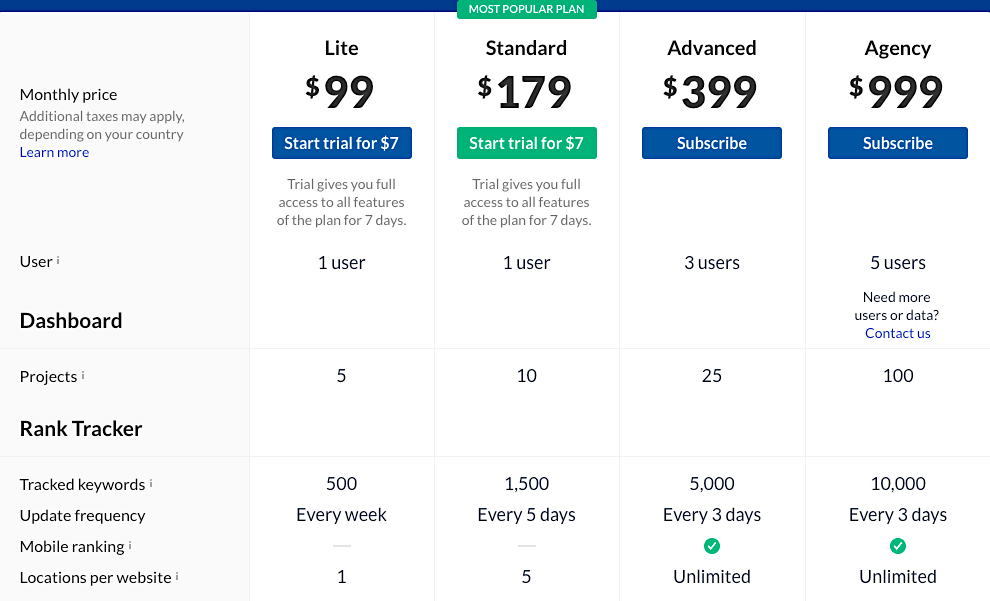
Ahref’s Content Explorer isn’t the only tool you can use to uncover your competitors’ content strategies, however.
SEMrush’s Content Analyzer is another option that includes a content audit feature, which tells you when content was most recently updated and the number of shares a given piece of content received across social media:
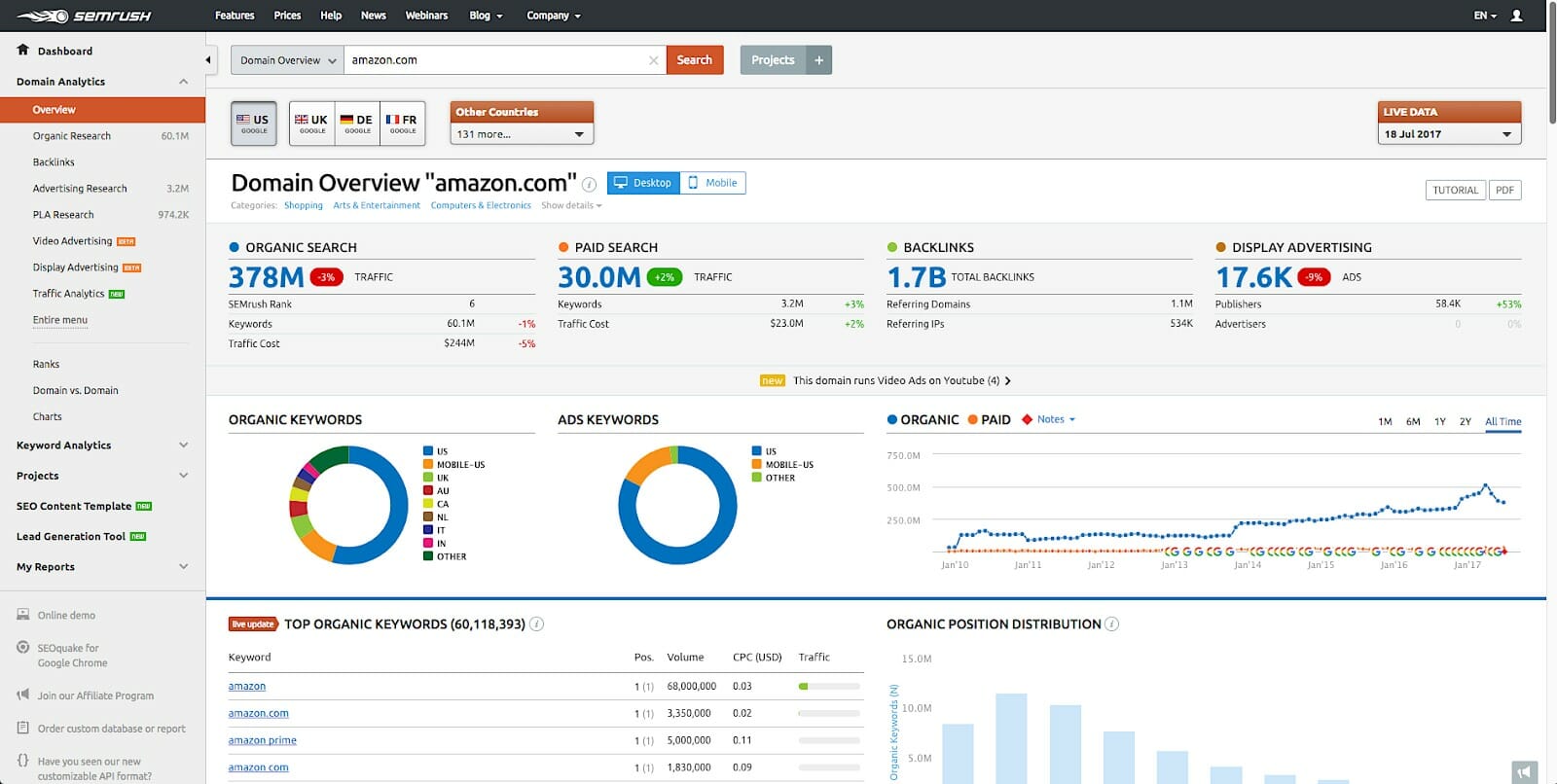
Plus, you can even compare two URLs to see which one performed better – this is great for measuring your content on a certain topic against similar content by your competitors.
SEMrush’s tool is comparable to Ahrefs, price-wise, and they both offer free trials. If you aren’t currently using either tool, you can try them both before you decide to buy.
Dive Deeper: Google’s Biggest Search Algorithm Updates Affecting Your Traffic in 2019 [Infographic]
How to Use Your Competitor’s Content Strategy to Your Advantage
So once you’ve collected all of this data about your competition, what do you do with it? Start with a SWOT analysis.
SWOT stands for Strengths, Weaknesses, Opportunities and Threats, and analyzing it is a vital part of any competitive marketing analysis. This approach is usually used to examine businesses as a whole, but you can scale it down to just focus on content marketing as well.
Here’s what you want to look for when evaluating how your content measures up to your competitors under each category:
Strengths
What are your competitors doing well, and what can you learn from their example? How does their content compare to your own? A few elements to consider include:
- Word count: Often, the longer the content, the better it’ll perform. What is your average post length compared to your competitors’?
- Format: Is the content scannable and easy to read, with headers and bullets to break up the text?
- Publish date: How new is the content?
- Last updated: How up-to-date is the content, and when was it last updated?
- Keyword ranking: Whose content ranks higher for important keywords in Google?
Although Content Explorer will mostly give you quantitative data, don’t forget to consider a qualitative analysis as well. If the content that your competitors are producing is genuinely better than yours in terms of providing value for your audience, it won’t be long before it outranks yours.
Weaknesses
Next, take a look at the worst-performing content from both you and your competitors, and see if you notice any patterns. Analyze it against the strengths list to highlight the specific areas where it’s falling short.
Opportunities
Now that you know your competitors’ weaknesses, you can focus on making them your strengths. For example:
- If their average word count is 900 words, make yours 1,900 (the average Google first page post is 1,890 words).
- If they’re creating video content, chances are you should do it too (just be sure to post the transcript with the embedded video on your blog to get the SEO boost).
Run the URLs for their most popular pages through Ahrefs, SEMrush or whichever tool you’re using for competitive analysis. Have they been updated recently? Do they have broken links? Create content on the same topics, with links to relevant, recently published content and up-to-date information.
At the end of the day, your opportunities are all about taking what your competition is failing at and turning it into a success for you.
Threats
Your threats are the areas where your competitors are either already taking your business or have to potential to. If you see that one of your competitor’s landing pages is one of their most popular pages – and has vastly more traffic than your landing page for a competing product or service – then you know that you need to improve your conversion funnel, stat.
Likewise, if your competitors have positive mentions all over the Internet and you don’t, then you need to get your happy customers to start singing your praises in a big way, or enlist an influencer to review your product.
Using Competitive Analysis to Create a Killer Content Marketing Strategy
Now that you know what you need to work on, content-wise, it’s time to revise your content marketing strategy (or, if you don’t have one, it’s time to create one). These three questions will help you define your strategy:
Who is my target audience?
This is by far the most important question you need to answer. If you’re an agency, what kind of clients do you serve and, most importantly, what kind of clients do you want to serve?
If those groups are the same, then this part is easy. If they aren’t, then you need to determine if you need to shift your idea of your ideal customer, or if you need to change your strategy to reach a different type of client.
What do they need?
In business, there’s something called the “success gap” – the space between your customer’s desired outcome and your business goals. If you have an app, your goal is to get people to use it. Your customer has a different goal, though. So your app is solving a problem for them.
What can you provide them that will help them use your app to solve their problem? If you have a productivity app, for example, maybe they need to see case studies of how other customers have used it to streamline their lives.
A good way to answer this question is to read reviews of your product or service and look through your customer service history. What are your customers’ pain points? How are they not meeting their goals? Do the same for your competitors. Are they bridging the success gap or do their customers have the same complaints as yours?
If you can eliminate the success gap, not just for your own customers but for your competitors’ as well, you’ve provided true value with your content. That value is likely to translate to brand trust and increased revenue.
Where are they?
This question may be a bit tougher to answer. If you’re a B2B business, LinkedIn is a good place to start. If you’re a B2C targeting millennials, Instagram and YouTube may be your best channels. If you’re a B2C that skews older folks, Facebook or good old-fashioned email are no-brainers to try.
Dive Deeper:
- How to Build a High-Performance Content Marketing Strategy
- How to Optimize Your Content Strategy with the Buyer’s Journey
- Why Competitive Analysis Is the Key to Early Success
Your Strategy: Do It Better Than Your Competitors
Once you’ve answered these questions on your competitors’ content campaigns, you can develop your own strategy. Take the metrics you’ve already compiled on how your competition’s content is performing and what keywords they are ranking for, and use that information to create something better.
For example, say one of the top 10 articles from your competitor is called “Top 10 SEO Tips,” which was published in 2017, hasn’t been updated since and links out to an SEO tool that’s no longer live.
To beat them, you could create an article titled, “Top 25 SEO Tips for 2019,” that’s longer, contains more up-to-date information about Google’s algorithm, links to popular, current SEO tools and includes all the keywords the original article ranked for. With a little promotion, it shouldn’t take long for your article to rank higher than your competitor’s.
Once you’ve created the article, promote the heck out of it through your marketing channels using our Content Sprout Method. Boost it on your social media pages. Send it out to your email list. Upload a short video hitting the main points on YouTube. Create a 30-second teaser for Instagram.
Another way to get your content out there is by Broken Link Building (BLB). Find links to broken content on websites in your niche and send them links to replace that content. You can do this through Ahrefs, SEMrush, or with free tools like the Check My Links Chrome extension.
Once you’ve pushed all that content out there, study your metrics. Double down on what worked, and try new tactics for what didn’t. That boosted Facebook post didn’t get any conversions? Try a live video next time. Or a discount offer. Keep testing and keep refining your content marketing strategy. And keep looking at your competition’s metrics, too, so you’ll know when they catch on to what you’re doing.
Dive Deeper:
- The Skyscraper Technique: How to Build High-Quality Backlinks to Your Content
- The #1 Marketing Strategy for 2019: The Content Sprout Method
- Omnichannel Marketing: Using the Content Sprout Method to Overcome Info Overload
You Can Beat Your Competitors
When it comes to pulling ahead of your competition, learning about their tactics and what’s working is the most important information you can have. Not only can you emulate their strategies, but, over time, through trial and error, you can surpass them.
If you do all that and don’t achieve success, then take a long, hard look at your product or service to find out if it’s your offering, not your messaging. Maybe it’s an easy fix, like adding a new feature that your competitor offers or adjusting your pricing. Maybe it’s not so easy.
Marketing is all about learning. When you have the right product, the right strategy and the right tools, you have everything you need to turn your knowledge into a successful business.



